In St Mary's City - 38:11.50N, 76:26.10W

AJAYA'S CRUISE
Phil & Nikki Hoskins
Mon 31 Aug 2009 16:58
|
At the mouth of the Potomac on the
Maryland coast lies St Mary's City on the St Mary's River. This is a place
of huge historical interest to Americans, as it was the capital of Maryland
in the early 17th Century, before that status was subsequently
bestowed on Annapolis some years later. St Mary's was only the 3rd settlement
established by the British after Jamestown & Plymouth
when they ventured into these parts, although this area of
Maryland was already inhabited by the Yaocomaco Indians, an independent
tribe of the Piscataway nation, who proved to be a friendly bunch that
fished the river and worked the land. The friendliness could have
been affected by the various firearms the British banded around on
their arrival perhaps, but that's being cynical. Arrive the British certainly
did, in two ships, the Ark (nothing to do with Noah) of some 400 tons and the
Dove, a small pinnace of some 60-70 ft and 40 tons that had both sailed
from Cowes on the Isle of Wight in 1633. The Arc was much bigger, but the
Dove was ideal for exploring ahead of it's larger companion ship.
 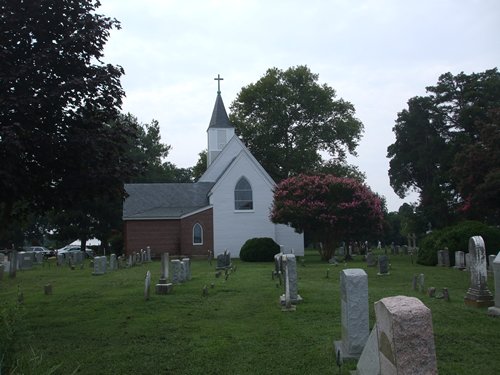 The large bay at St
Mary's
The old churchyard
The story is told that the Yaocomacos were being
harassed by their nasty neighbours the Susquehannocks, so when the British
offered to buy some land off the Yaocomacos, who were about to move
out of the area anyway they must have thought all their totem poles were
in harmony that day, as it gave them the chance to skedaddle across the
river and let the British deal with the Susquehannocks. What's more, they even
let the British move into their huts so they had somewhere ready to live in
whilst they built something more traditionally British. They purchased it from
the Indians in exchange for blankets, cloth, knives, trinkets, axes, hoes and
other tools. Hhhmm - those axes could have been risky in the wrong
hands!
The Indians did teach the newcomers farming methods
so they could make the most of the new land they were settling onto. They
renamed the village St. Mary's. (We did wonder if we British were stitched up a
little at St Mary's and how shocked those bullying Susquehannocks were when
they next attacked the village of the Yaocomacos). But who can be sure what is
fact and what makes a good story where history is concerned. What
is known is that one of the Chief's daughters Mary Kittamaquand was sent to live
with the British as a 7 year old girl in 1641 so as to learn the customs and
language of the new settlers. Poor wretch! She married an English settler
4 years later who was suspected of using it as a way of securing rights to
Indian lands. (An early example of 'gold digging' perhaps).
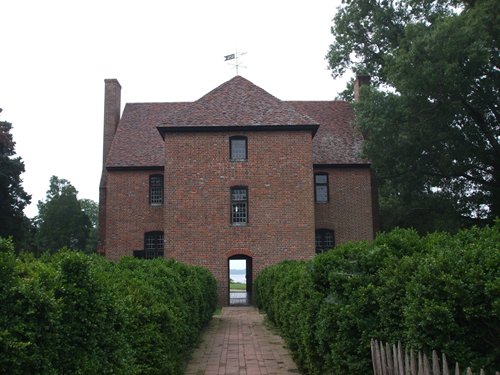  The reconstructed State
House
Inside the State House
What we do know is that St Mary's did become a
large settlement where a seat of Government was established and a constitution
drawn up for a way of life that had religious tolerance at it's centre,
considering that England in those times was strictly Protestant but
would shortly erupt into civil war. The first Catholic church in the new world
was established at St Mary's but at the outbreak of the English civil war it was
closed down by Protestants living in nearby Virginia. The only place outside of
the Mother country affected directly by the Civil War.
For some years there has been an archaeological
programme underway at St Mary's to unearth and re-construct the past. There is a
vessel built locally that although not being a replica of the Dove, is an
interpretation of what it may have looked like. This is moored on a jetty at St
Mary's and is included as part of the tour round the site.
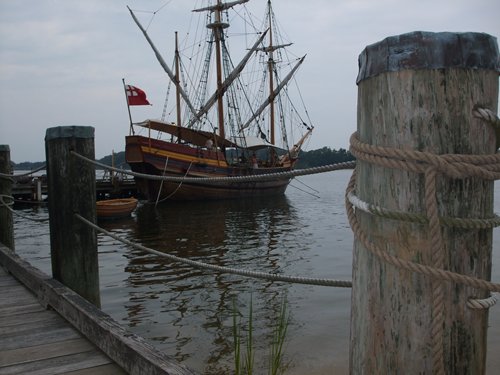 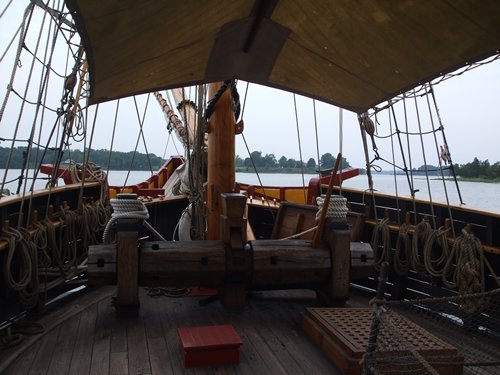 What the Dove may have looked
like......
Note the horizontal windlass for raising the anchor
Having dropped anchor in the large protected
horseshoe shaped bay off St Mary's City we paid our $20 for the tour and walked
round the large well marked path which led to the
various buildings which had been erected on the original site of St
Mary's City. This is a living museum/site so they have people dressed up as the
British settlers to give an air of authenticity, until we came to the Indian
huts where we were met by a young American girl not dressed as an Indian. This
is where we ran into our first issue of political correctness, as it was
explained to us that it wasn't considered ethical to dress a white American
in an Indian's costume, although strangely enough this hadn't stopped the
Americans elsewhere on the site dressing up as British settlers. Maybe it was
pertinent that the native Indians in those days shaved their heads and wore very
little which could have proved to be a problem getting volunteers to
take on the role. We moved on, and spent some time talking to the man that was
minding the printing press, which was the only one in Maryland at that time. A
fascinating piece of machinery, it reminded us of how difficult printing was in
those days with 1000's of tiny little lead pieces for letters all laid
out in open boxes. He could actually feel what each letter was without
looking at the typeface. A catastrophe should the box be accidentally upset, but
a bigger problem he mentioned was the parties of school children touring the
site who's little fingers would attempt to take samples or mix up the letters
!!
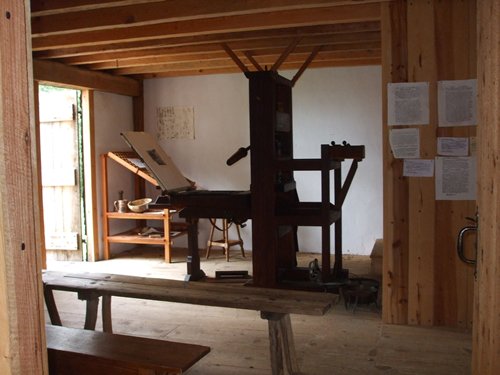  The printing
press
Skip listening to a young lady describe life in an 'Ordinary' (name for a
'B&B' in those times)
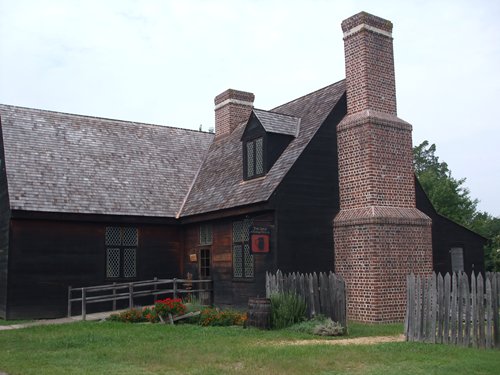  'Farthing's Ordinary '- used as the gift shop
on
site
Exploring the interior of the Indian hut - wigwams or tepees weren't
used in these parts.
  These are called 'Ghost houses' which depict
where various dwellings
existed
One of the many paths covering the site
We would have spent more time walking round the
site as the history here is fascinating. A short distance away was
the tobacco plantation that brought great wealth to the area, but a distant
roll of thunder reminded us there was a storm on the way which had been forecast
for later that day so we hurried back towards where we left the dinghy.
Unfortunately we didn't hurry enough and the storm was upon us as we got to
within striking distance. Ajaya was about 200 yards offshore, but we didn't even
make it to the dinghy as the heavens opened and torrential rain descended. We
took shelter at the St Mary's College sailing compound as the lightening started
to streak down close by, with one simultaneous clap of thunder and streak of
lightening that clearly hit the opposite bank of the creek. We watched Ajaya,
wondering if this would be the time she would get hit - at least we were safe.
The wind generator was flying round as the wind was now approaching 30 knots.
The storm was quick moving though and as the lightening strikes passed steadily
into the distance we headed for the dinghy (which was full of water naturally)
and reclaimed our floating home which was unaffected by the passing
storm.
|